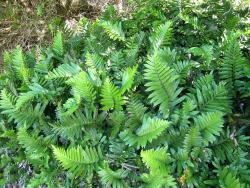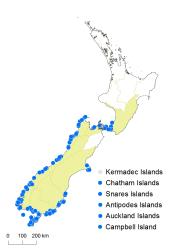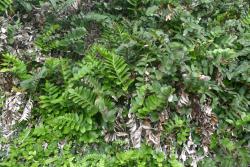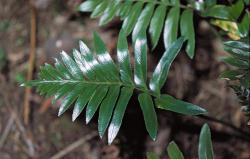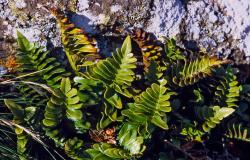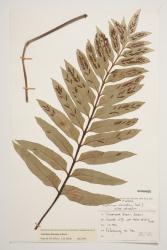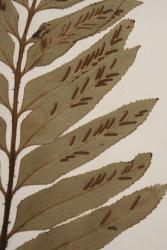- ≡ Asplenium marinum var. obtusatum (G.Forst.) F.Muell., Veg. Chatham Isl. 66 (1864) – as obtusata
- = Asplenium obliquum G.Forst., Fl. Ins. Austr. 80 (1786)
- ≡ Asplenium obtusatum var. obliquum (G.Forst.) Hook.f., Bot. Antarct. Voy. I. (Fl. Antarct.) Part I, 108 (1844)
- ≡ Asplenium lucidum var. obliquum (G.Forst.) T.Moore, Index Fil. 142 (1859)
- = Asplenium apice-dentatum Hombr. in Hombron & Jacquinot, Voy. Pôle Sud, Bot. t. 1a (1843)
Terrestrial or rupestral ferns. Rhizomes short, erect or short-creeping, sometimes forming a hard woody mass above ground, bearing scales. Rhizome scales ovate or narrowly ovate, 10–28 mm long, 1–10 mm wide, brown, clathrate. Fronds 60–1000 mm long. Stipes 25–540 mm long, dark brown proximally and green distally, or brown throughout, bearing narrowly ovate scales with acute or acuminate apices. Rachises green, scaly. Laminae 1-pinnate, ovate or elliptic, narrowed to a short undivided or rarely lobed terminal segment with serrate margins similar to the primary pinnae; laminae 27–540 mm long, 23–290 mm wide, dull green on both surfaces, thick and fleshy, bearing scales on the abaxial surface, lacking hairs. Primary pinnae in 3–23 pairs below the apical segment, not or only slightly overlapping, all narrowly ovate or narrowly oblong; the longest at or near the base, 11–180 mm long, 8–30 mm wide; pinna apices rounded or obtuse or acute or rarely acuminate, margins serrate, bases cuneate and stalked. Sori away from margins; indusia 3–22 mm long, straight; free margins of indusia entire. Mean spore size 40–43 μm long, 24–27 μm wide; perispores slightly winged but with few crests or ridges.
Asplenium obtusatum is morphologically very similar to A. decurrens and A. oblongifolium. It occupies a similar coastal habitat to A. decurrens and is only distinguished by its slightly larger laminae (27–540 mm long, 23–290 mm wide, cf. 23–370 mm long, 15–160 mm wide), broader stipe scales, smaller spores (40–43 × 24–27 μm cf. 45–52 × 29–33 μm) and tetraploid chromosome number. However, the two species are geographically separated, A. decurrens occurring north of the western Waikato coast and A. obtusatum only south of Kapiti Island. Asplenium obtusatum is distinguished from A. oblongifolium by its thick fleshy fronds, often rather round-ended pinnae, and narrowly ovate, rather than hair-like, stipe scales. Both species can occupy coastal habitats, but A. obtusatum does not extend into inland areas.
In the subantarctic and southern South Island A. obtusatum occurs together with A. scleroprium in coastal regions. Asplenium obtusatum is distinguished by its less deeply serrate and more obtuse pinnae, and sori that do not reach the margins.
Asplenium obtusatum can occasionally be confused with small 1-pinnate plants of A. lyallii. However, they generally have thicker, fleshier fronds, occupy a strictly coastal habitat, and have a less divided terminal pinna.
Plants of A. obtusatum produce their largest fronds on the islands of Foveaux Strait and the subantarctic. They gradually diminish in size northwards, with only rather small plants occurring around Wellington. This is in contrast to plants of A. decurrens, which produce their largest fronds on the Kermadec and Three Kings Islands, gradually decreasing in size southwards.
North Island: Southern North Island.
South Island: Western Nelson, Sounds-Nelson, Westland, Canterbury, Otago, Southland, Fiordland.
Chatham Islands, Solander Island, Stewart Island, Snares Islands, Antipodes Island, Auckland Islands, Campbell Island.
Altitudinal range: 0–190 m.
Asplenium obtusatum occurs in a few coastal localities on either side of Cook Strait, and more or less continuously around the west and south coasts of the South Island, extending north to Moeraki Point on the east coast, with outlying populations on Banks Peninsula. It also grows on the Chatham Islands, Stewart Island, the islands of Foveaux Strait, and all the subantarctic islands. It is strictly coastal, reaching up to 80 m at Nugget Point, Catlins district, and up to 190 m on the Otago Peninsula.
Tetraploid populations of A. obtusatum are known from Tristan da Cunha (Manton & Vida 1968), but morphologically similar plants are also known from southern South America and many islands in the Southern Ocean, but whether these belong to A. obtusatum or to the octoploid A. decurrens is unknown.
In the northern part of its range Asplenium obtusatum is a rather small plant growing on exposed coastal rocks, often in seepages or sometimes amongst coastal grasses, but in the south it grows much more luxuriantly on exposed cliffs and under coastal forest or scrub with Phormium, Veronica elliptica, and Blechnum blechnoides or B. durum, where fronds can reach up to 1 m long. On Stewart Island and in the subantarctic, A. obtusatum grows under Olearia lyallii and Metrosideros umbellata. Nowhere does it extend beyond the influence of salt spray.
There is evidence that A. obtusatum hybridises with A. bulbiferum, A. chathamense, A. flaccidum subsp. flaccidum, A. lyallii (Brownsey 1977b), and A. gracillimum (newly recorded here). Some of the plants included in the cultivar "Maori Princess" may result from a hybrid between either A. oblongifolium or A. obtusatum and A. bulbiferum.
n = 72 (Brownlie 1958; Brownsey 1977).
The name Asplenium obliquum G.Forst., and combinations based on it, were treated as synonyms of A. obtusatum G.Forst. by Brownsey (1977). However, the combination A. lucidum var. obliquum (G.Forst.) T.Moore is incorrectly formed and cannot be used because the species name, A. lucidum G.Forst., is a later homonym of A. lucidum Burm.f. and therefore illegitimate (Brownsey 1979).
Asplenium obtusatum was previously considered to include both subsp. obtusatum and subsp. northlandicum (Brownsey 1977). However, Shepherd et al. (2008) showed that A. decurrens (as A. northlandicum) is an allopolyploid species, with either A. obtusatum or A. oblongifolium as the chloroplast parent and an unknown tetraploid as the other parent. Their conclusion supported the recognition of A. decurrens as a distinct octoploid species, rather than a subspecies of the tetraploid A. obtusatum.



